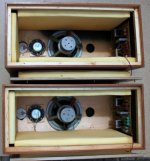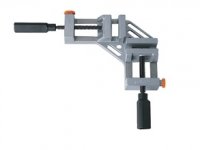I've used 5 mm thick bitumen in the following way: double layers on top/bottom and large pluss smaller sheet on both sides and back.
Sounds like good advice. And don't forget to staple it as well as stick it on. The self adhesive pads all peel off over time.
David S.
I thought I'd share a quick photo of my new thin-wall aperiodic cabinets for Exotic. No finish yet, but here goes:
An externally hosted image should be here but it was not working when we last tested it.
9 mm birch plywood damped with bitumen and with beech fillets.
That looks very smart. I'd be tempted to keep it in ply.
What's the size?
I've used enough nail 🙂
I'll sand and oil the ply, that's the plan.
I'll sand and oil the ply, that's the plan.
An externally hosted image should be here but it was not working when we last tested it.
What you are saying in essence, speaker dave, is that it's alright to entrust part of the treble signal to a vibrating plank of wood. To me this is a chaotically implemented mechanical filter.In the end the tweeter signal and the panel vibration will add
I'd be tempted to double up the damping thickness to 8mm, if possible. The 12-13mm birch is a good shell, but the idea is to get to a more extreme damping to wall thickness ratio. Surface damping is generally inefficient, so a good thickness is desirable. (Read up on constrained layer damping.)
Can you get Finnish plywood in your area?😉
I think there is wood store who has baltic birch ply in stock as much I like to buy and he will saw them in pieces by drawings 😉
-----
Is bitumen pads good damping?
What you are saying in essence, speaker dave, is that it's alright to entrust part of the treble signal to a vibrating plank of wood. To me this is a chaotically implemented mechanical filter.
That was thing I meant, I don't want vibration to modulate higher frequencies. But maybe matter is so that thinner panel vibrates at lower frenquencies and thicker panel vibrates at higher frequencies that smear more?
What you are saying in essence, speaker dave, is that it's alright to entrust part of the treble signal to a vibrating plank of wood. To me this is a chaotically implemented mechanical filter.
The discussion is about how to reduce the vibration of cabinet walls so the Harwood approach, if anything, will reduce tweeter motion.
I was alluding to the audiophile notion of tone arm bearing slack creating a threshold of uncertainty below which all signal is lost. This notion goes back to Ivor Tiffenbrun of Linn Sondek fame, an infinitly better marketeer than scientist.
In the end, if panel motion is moving the tweeter the signals will add. You could probably argue that a little bit of FM (Doppler) would be created and look for low frequency sidebands on high frequency tones. Good luck finding them and especially good luck convincing others that you can hear them. At the same time we should investigate how LF air pressure from the woofer drives the dome. You would not be able to seperate one effect from the other.
David S.
Is bitumen pads good damping?
Yes, they are traditionally used to dampen car body panels and such, and are probably the best of the surface treatments. If you want to get a little more exotic you can do a search for high loss glues and consider gluing ceramic tiles to the interior. This would get you into the constrained layer approach that tends to be more efficient.
Read through the previous thread mentioned on the first page, I think it goes into that.
Regards,
David S.
Point taken, although it is impossible to decouple two drivers driving the same air space. It is an inevitable compromise.we should investigate how LF air pressure from the woofer drives the dome
Yes, they are traditionally used to dampen car body panels and such, and are probably the best of the surface treatments. If you want to get a little more exotic you can do a search for high loss glues and consider gluing ceramic tiles to the interior. This would get you into the constrained layer approach that tends to be more efficient.
Read through the previous thread mentioned on the first page, I think it goes into that.
Regards,
David S.
Okay. I have car parts store nearby which sells 4 mm bitumen like in this picture
I'll buy it and damp bottom, roof and side with it with one layer. I think bitumen does not have to cover all of side panel? I mean, maybe it's enough if 400x300 mm panel is damped with 360x280 bitumen?🙂 Also, if another layer is applied, second bitumen could be like 300x230 mm etc.
Back panel of speaker attached with screws (+seal), not by glueing?
I remember that bitumen is good for damping because it converts vibration into heat? I think ceramic tiles may not be as good in that so I'm not going to try them right now.
I think bitumen does not have to cover all of side panel? I mean, maybe it's enough if 400x300 mm panel is damped with 360x280 bitumen?🙂 Also, if another layer is applied, second bitumen could be like 300x230 mm etc.
Yes, I think that is a typical application. You will know that the end result works when a "nuckle rap" gives a very dull and un"woodlike" sound.
Regards,
David
I can recommend downloading the original article. It's full of useful information.
Harwood found coverage of 50% of the panel area was sufficient and that the resonance was lowered to an area where the ear was less sensitive.
Bear in mind that this research was done to arrive at the most economical method of getting the results they needed, as the manufacture was being passed to commercial concerns to produce under licence to teh BBC. It doesn't mean his guidelines are the ultimate best - you may be able to improve.
Harwood found coverage of 50% of the panel area was sufficient and that the resonance was lowered to an area where the ear was less sensitive.
Bear in mind that this research was done to arrive at the most economical method of getting the results they needed, as the manufacture was being passed to commercial concerns to produce under licence to teh BBC. It doesn't mean his guidelines are the ultimate best - you may be able to improve.
I can recommend downloading the original article. It's full of useful information.
+1
Semi offtopic,
do anyone give practical tips how to assemble thin walled ply wood box if I don't want any screws to be visible? I'm going to saw pieces and cut side and bottom/top panels with 45 degrees angles so structure of ply wood shows nicely (no edges). Maybe I have to make "skeleton" of 20x20 mm bar inside the box. Front and back to be attached into that skeleton by screws. Front and back NOT by 45 degrees but like in BBC boxes. (like this http://www.sonicflare.com/01 - Harbeth P3ESR black and white - Title-thumb-600x324.jpg)
do anyone give practical tips how to assemble thin walled ply wood box if I don't want any screws to be visible? I'm going to saw pieces and cut side and bottom/top panels with 45 degrees angles so structure of ply wood shows nicely (no edges). Maybe I have to make "skeleton" of 20x20 mm bar inside the box. Front and back to be attached into that skeleton by screws. Front and back NOT by 45 degrees but like in BBC boxes. (like this http://www.sonicflare.com/01 - Harbeth P3ESR black and white - Title-thumb-600x324.jpg)
Yes, you have to build a frame to support it, preferably in beech and definitely not soft wood. Fasten the frame to the walls from the inside, and you won't get any visible screws. I used dowels and glue.
It's also recommended to use brass screws for fastening the front and back to the fillets.
It's also recommended to use brass screws for fastening the front and back to the fillets.
Last edited:
Here is nice picture of old Spendor where frame is shown. It is easy to fasten frames to panels with short screws (and with glue). Harder is how to fasten sidepanels to each other if 45 degree angles are used and screws NOT allowed to be visible? It would be much easier if inner frames are done by one circular frame, not from 4 individual sticks.
Another problem is how to prevent box not to go into diamond. Maybe have to fasten back and front panels temporary to side panels.
Another problem is how to prevent box not to go into diamond. Maybe have to fasten back and front panels temporary to side panels.
Attachments
Look up som photos of Harbeth, some of them show off the inside pretty nicely.
You can either build the framework and fasten the walls afterwards, or you can fasten the fillets to the walls and then glue everything together. No need for screws from the outside in any of those approaches. I went with the latter, and used dowels instead of screws.
Use corner clamps.
You can either build the framework and fasten the walls afterwards, or you can fasten the fillets to the walls and then glue everything together. No need for screws from the outside in any of those approaches. I went with the latter, and used dowels instead of screws.
Use corner clamps.
Look up som photos of Harbeth, some of them show off the inside pretty nicely.
You can either build the framework and fasten the walls afterwards, or you can fasten the fillets to the walls and then glue everything together. No need for screws from the outside in any of those approaches. I went with the latter, and used dowels instead of screws.
Use corner clamps.
What do you mean by fillets?
And by corner clamps you mean those 90 degree steel "things"? (sorry my bad english)
http://kauppa.taloon.com/kuvat/k/wurth/kulmarauta_perus.jpg
------
About thickness, do you think that 12 mm baltic brich ply would be too thick if speaker dimensions are just 225x450x300 mm? Next smaller thickness is 9 mm, that is really thin but could it be better in this case (with 2x4 mm bitumen damping)?
Last edited:
I would normally never use the word ´fillets´, but it's commonly used in literature about the BBC cabinets. It's the wood used for the internal skeleton.
I've attatched a picture of the clamps I'm referring to. It's to hold the cabinet walls straight while gluing it together.
9 mm with 2x4 mm bitumen would fit the bill for your cabinet, no need to make it 12 mm.
I've attatched a picture of the clamps I'm referring to. It's to hold the cabinet walls straight while gluing it together.
9 mm with 2x4 mm bitumen would fit the bill for your cabinet, no need to make it 12 mm.
Attachments
Last edited:
- Status
- Not open for further replies.
- Home
- Loudspeakers
- Multi-Way
- BBC Thin Wall Enclosure - Ported?

